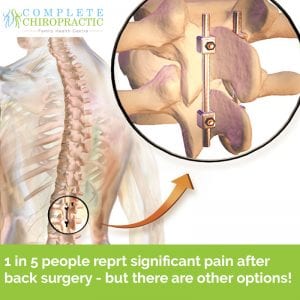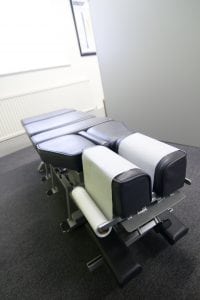In some cases, spinal surgery can be the right choice – but many turn to it before fully exploring the non-surgical options open to them, and some medical practitioners even recommend it as a first choice. This week, let’s look at some of the risks involved in this option.
What kinds of spinal surgery are common?
The most common kind of lower back surgery performed to ease lower back pain is lumbar fusion, in which two of the vertebra are permanently fused together. The most common lumbar fusion procedures are posterior lumbar interbody fusion, anterior lumbar interbody fusion, transforaminal interbody fusion, and lateral lumbar interbody fusion While in some cases surgery can reduce pain and improve quality of life, all of these procedures ultimately change the way the spine works. While spinal surgery does not usually mean that a person cannot explore further non-surgical options after treatment, it does complicate the cases and may make some treatment methods impossible, so It’s strongly advised to explore all conservative options first.
Spinal surgery, possible risks
Severe pain after surgical procedures is a major factor leading to patient dissatisfaction, delayed recovery, immobility, and prolonged hospital stay and is associated with serious complications.[1] It also appears that older patients are more likely to suffer with pain after surgery -, Kalanithi et al. have demonstrated a 70% increase in the rate of complications following lumbar fusion in patients over 65 years of age compared with patients between 45 and 64 years of age.[2] The most common complications associated with fusion surgeries are intraoperative neurologic injury, interbody implant or bone graft migration, dural tear, infection, heterotopic ossification, postoperative radiculopathy, osteolysis, and subsidence. Although there have been advancements in surgical technique and technology, the incidence of pain after surgery is still very high.
In many kinds of fusion surgery, the nerve roots (which are responsible for sending pain signals) must be retracted to gain access to the posterior disk space. Matsui et al. observed a correlation between decreased blood flow and tension placed on the nerve during retraction, and have suggested that this may be associated with ongoing pain.[3] Radiculopathy is the most commonly reported postoperative nerve injury
Infection is a complication that may not manifest until much later in the postoperative course—even more than 2 years after surgery.[4] To be fair, infection is a risk for any kind of surgery – not just back surgery – but infections following fusion surgery do affect up to 9% of patients.[5] The most common infectious organism is Staphylococcus aureus, and additional risk factors appear to include smoking, diabetes, prolonged operative time, large volume of blood loss, previous surgery, and use nonautograft bone graft alternative.[6] Spinal infections are typically managed with intravenous antibiotics and are usually relatively straightforward to treat, but this obviously adds recovery time for the patient, and considerable cost. One US study estimated that postoperative infections add approximately $29,000 in hospital cost per patient.[7] Optimization of preoperative patient nutrition and smoking cessation can aid in the prevention of infection, however.
Given the technical difficulties of placing devices, such as screws in the spine, it is inevitable that complications occasionally arise from mispositioning of hardware. Implant migration – that is to say, the movement of implanted hardware – may occur because of lack of stability across the segment or loss of normal bone implant apposition.[8] Posterior implant migration is rare, but serious complications often lead to revision surgery. Implanted hardware exists solely to provide short-term stability while fusion develops. Inadequate fixation and subsequent motion may cause the bone graft to resorb rather than be incorporated, which, in turn, puts hardware at risk of fracture.[9] Pedicle screws, in particular, deserve attention because of their frequent use and proximity to sensitive neural and vascular structures. The most common clinical complication of hardware malposition is nerve root irritation – which you may well have heard described by people who have undergone back surgery, it’s a very common problem.
Successful surgery fundamentally changes the spine
Even if surgery goes off without a hitch, it still represents a fundamental change the way your body works. Successful fusion permanently alters the mechanics of the spinal segments at adjacent levels. The resulting problem with fusion is that the lost mobility of the fused segment forces additional stresses on adjacent levels of the vertebral column – while this may help to relieve the immediate problem, increased stress from fusion may cause microtrauma to the intervertebral disks at adjacent levels, accelerating the degenerative changes in those vertebrae, ligaments, and intervertebral disks.[10] Adjacent segment disease, also known as junction failure, occurs in up to 10% of patients following posterior fusion.[11]
Is there an alternative?
In some cases, spinal surgery is the best option despite the possible complications, and the amount of research which is being carried out on spinal surgery at an almost constant pace is helping to reduce the risk of complication. However, it is clearly advisable to explore all your non-surgical options before making a permeant change to your spine. There’s no getting away from the fact that spinal pain – and severe pain at that – has been reported in about 1 in 5 patients who have undergone various surgical procedures, and only poor to fair pain relief has been possible despite pain management therapies. [12]
Chiropractic care, while not a panacea, has a strong record in dealing with all forms of back pain, and thought the use of advanced methodologies such as chiropractic biophysics, we are able to assist clients with complex painful conditions – even where other chiropractic treatment has failed. Before you consider spinal surgery, why not schedule an initial consultation and get a chiropractic opinion, before going under the knife?
[1] Katz J., Seltzer Z.
Transition from acute to chronic postsurgical pain: risk factors and protective factors.
Expert Rev Neurother. 2009;9(5):723–744
Kehlet H., Jensen T.S., Woolf C.J.
Persistent postsurgical pain: risk factors and prevention.
Lancet. 2006;367(9522):1618–1625
[2] Kalanithi P.S., Patil C.G., Boakye M.
National complication rates and disposition after posterior lumbar fusion for acquired spondylolisthesis.
Spine (Phila Pa 1976) 2009;34(18):1963–1969
[3] Matsui H., Kitagawa H., Kawaguchi Y., Tsuji H.
Physiologic changes of nerve root during posterior lumbar discectomy.
Spine (Phila Pa 1976) 1995;20(6):654–659
[4] Richards B.S.
Delayed infections following posterior spinal instrumentation for the treatment of idiopathic scoliosis.
J Bone Joint Surg Am. 1995;77(4):524–526
[5] Chen Z., Zhao J., Liu A., Yuan J., Li Z.
Surgical treatment of recurrent lumbar disc herniation by transforaminal lumbar interbody fusion.
Int Orthop. 2009;33(1):197–201
Crandall D.G., Revella J.
Transforaminal lumbar interbody fusion versus anterior lumbar interbody fusion as an adjunct to posterior instrumented correction of degenerative lumbar scoliosis: three year clinical and radiographic outcomes.
Spine (Phila Pa 1976) 2009;34(20):2126–2213
Xu H., Tang H., Li Z.
Surgical treatment of adult degenerative spondylolisthesis by instrumented transforaminal lumbar interbody fusion in the Han nationality.
J Neurosurg Spine. 2009;10(5):496–499
[6] Richards B.S.
Delayed infections following posterior spinal instrumentation for the treatment of idiopathic scoliosis.
Olsen M.A., Nepple J.J., Riew K.D.
Risk factors for surgical site infection following orthopedic spinal operations.
J Bone J Surg Am. 2008;90(1):62–69
Fang A., SS H., Endres N., Bradford D.S. Risk factors for infection after spinal surgery.
Spine (Phila Pa 1976) 2005;30(12):1460–1465
[7] Parker S.L., Adogwa O., Wtham T.F., Aaronson Q.S., Cheng J., McGirt M.J.
Post-operative infection after minimally invasive versus open transforaminal lumbar interbody fusion (TLIF): literature review and cost analysis.
Minim Invasive Neurosurg. 2011;54(1):33–37
[8] Talia A.J., Wong M.L., Lau H.C., Kaye A.H.
Comparison of the different surgical approaches for lumbar interbody fusion.
J Clin Neurosci. 2015;22(2):243–251
[9] Talia A.J., Wong M.L., Lau H.C., Kaye A.H.
Comparison of the different surgical approaches for lumbar interbody fusion.
J Clin Neurosci. 2015;22(2):243–251
[10] Young P.M., Berquist T.H., Bancroft L.W., Peterson J.J.
Complications of spinal instrumentation.
Radiographics. 2007;27(3):775–789
[11]Cho K.J., Suk S.I., Park S.R.
Complications in posterior fusion and instrumentation for degenerative lumbar scoliosis.
Spine (Phila Pa 1976) 2002;27(7):776–786
Etebar S., Cahill D.W.
Risk factors for adjacent-segment failure following lumbar fixation with rigid instrumentation for degenerative instability.
J Neurosurg. 1999;90(Suppl 2):163–169
[12] Perkins F.M., Kehlet H.
Chronic pain as an outcome of surgery: a review of predictive factors.
Anesthesiology. 2000;93(4):1123–1133

